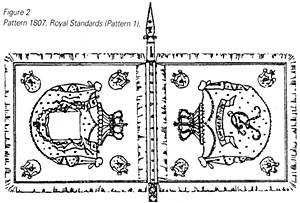
Konigliche Standartenmuster 1807 - Muster 1 (Royal Standards Pattern 1807 - Pattern 1) are illustrated at Figure 2. These were of a double thickness taffeta material with a flowery pattern in the weave. They measured 68 cm in the staff and 75 cms in the fly with a 6cm fringe as before. Fastening to the staff was by means of three rows of 12 nails through white braid. A further two rows of five nails were fixed either side of the shaft below the standard.
The obverse bore the FR monogram. The reverse design consisted of the Royal Arms described in the previous article. Further small heraldic cloaks with monograms decorated each corner.
The finial was a gilt spear point bearing the monogram and crowned arms on obverse and reverse respectively.
The staff was 232 cm long decorated as the Pattern 1803, Electoral Standards.
The distribution was as follows:
- 5th Squadron Chevaulegers-Regiment Herzog Heinrich. 1 yellow with white fringe.
5th Squadron Leibchevaulegers-Regiment. 1 poppy-red with white fringe.
In 1809 the Garde-Regiment zu Pferd was formed from the Garde du Corps squadron, Leibjager-Corps squadron and the fifth squadron of the two chevaulegers regiments. The new regiment received new pattern Royal Standards in vexillum form.
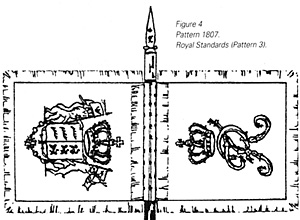 Konigliche Standartenmuster 1809 - Muster 2 (Vexillumstandarte) (Royal Standards Pattern l809 - Pattern 2 (Vexillum standard) are illustrated at Figure 3. These were of a double thickness silk and measured 48 cm high and 45 cm wide with a 5 cm fringe on all four sides, front and back. They were fixed to the 50 cm cross piece by two rows of 18 silver nails. This was finished with silver end caps and secured to a silver collar on the staff by means of a silver ring and clip device.
Konigliche Standartenmuster 1809 - Muster 2 (Vexillumstandarte) (Royal Standards Pattern l809 - Pattern 2 (Vexillum standard) are illustrated at Figure 3. These were of a double thickness silk and measured 48 cm high and 45 cm wide with a 5 cm fringe on all four sides, front and back. They were fixed to the 50 cm cross piece by two rows of 18 silver nails. This was finished with silver end caps and secured to a silver collar on the staff by means of a silver ring and clip device.
The obverse bore a silver embroidered crowned FR monogram. The reverse bore the central part of Royal Arms, or Kleine Konigliche Wappen, in silver embroidery flanked by a black lion and gold stag. This design established the pattern used on all subsequent standards and described fully in the context of the Pattern 1811 Royal Colours in the previous article.
The finial was a 18 cm crowned silver spread eagle mounted on a silver 'T' piece. The staff was black and 223 cm long.
The distribution was as follows:
- Regiment Garde zu Pferd. 4 white with silver fringe.
Later in 1809 the Dragoner-Regiment zu Pferd was raised. This regiment received conventional standards, rather than the vexillum design.
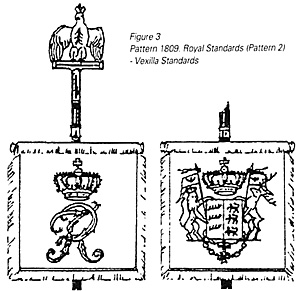 Konigliche Standartenmuster 1809 - Muster 3 (Royal Standards Pattern 1809 - Pattern 3) are illustrated at Figure 4. These were of a double thickness taffeta with a flowery pattern in the weave. They measured 50 cm in the staff and 56 cm in the fly with a 6cm fringe.
Konigliche Standartenmuster 1809 - Muster 3 (Royal Standards Pattern 1809 - Pattern 3) are illustrated at Figure 4. These were of a double thickness taffeta with a flowery pattern in the weave. They measured 50 cm in the staff and 56 cm in the fly with a 6cm fringe.
They were secured to the staff by three rows of 10 nails through white braid. A further two rows of five nails decorated either side of the staff beneath the standard.
The designs were nearly identical to those on the Pattern 1809 Vexilla. On the reverse was the Kleine Konigliche Wappen in pale yellow embroidery, flanked by a stag and a black lion. The obverse bore a pale yellow embroidered crowned FR monogram. The finial was a gilt spear point as described previously. The staff was black lacquer and 221 cm long.
The distribution was as follows:
- Dragoner-Regiment zu Pferd. 4 golden-yellow with white fringe.
The Decree of 26th May 1811 ordered that all existing Ducal and Electoral colour and standards should be replaced by Royal ones. As far as the cavalry were concerned this only affected the Chevaulegers regiments which carried Electoral presentations. It has been taken that 26th May 1811 was the date that the new emblems were actually presented. As was explained in the previous article concerning the infantry, the events of 1812 prevented this happening. The two Chevaulegers regiments fought in Russia under their old emblems.
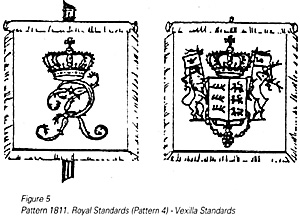 Konigliche Standartenmuster 1811 - Muster 4 (Vexillumstandarte) (Royal Standards Pattern 1811 - Pattern 4 (Vexilla Standard)) are illustrated at Figure 5. These standards for the two chevaulegers regiments were ordered to be like those of the Garde-Regiment zu Pferd and varied only in detail from the Pattern 1809 Royal Standards Pattern 2. They were of double thickness taffeta with a flowery pattern in the weave and measured 48 cm high and 45 cm wide with a 6cm fringe.
Konigliche Standartenmuster 1811 - Muster 4 (Vexillumstandarte) (Royal Standards Pattern 1811 - Pattern 4 (Vexilla Standard)) are illustrated at Figure 5. These standards for the two chevaulegers regiments were ordered to be like those of the Garde-Regiment zu Pferd and varied only in detail from the Pattern 1809 Royal Standards Pattern 2. They were of double thickness taffeta with a flowery pattern in the weave and measured 48 cm high and 45 cm wide with a 6cm fringe.
They were attached to the cross piece by two rows of 18 gilt nails, which was finished with gilt end caps and secured to the staff by means of a gilt ring and clip. The obverse bore a pale yellow embroidered crowned FR monogram of a slightly larger and more ornate design than the Pattern 1809 Vexillum. Noticeable also is that the monogram and crown now touch. The reverse bore the Kleine Konigliche Wappen in a pale yellow colour like that on the Pattern 1809 Royal Standards (Pattern 2). The attitude of the lion's head has changed slightly, now looking towards the stag rather than the viewer. Other minor differences are the hang of the pennants held by the two beasts and in the stag's antlers. The antlers on the shield also now have a pronounced down turn to them. The finial was a crowned 18 cm gilt spread eagle mounted on a gilt 'T' piece. The staff was black and 223 cm long.
The distribution was as follows:
- Chevaulegers Regiment Nr. 1. 4 yellow with white fringe
Leibchevaulegers-Regiment Nr. 2. 4 poppy red with white fringe.
During the 1809 campaign, at the Battle of Linz on 17th May, Jager Regiment zu Pferd Herzog Louis was ordered to attack some Austrian guns. These had been holding up the Wurttemberg attack, and were situated on a hill feature known as the Pfennigberge north of Katzbach. This celebrated action resulted in a Decree of 28th May 1809 awarding the presentation of an Honour Standard to the regiment.
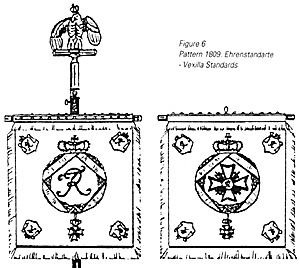 Konigliche Ehrenstandarte 1809 (Vexillumstandarte) (Royal Honour Standard 1809 (Vexillum Standard)) is illustrated at Figure 6. This standard was unique. It was made of double thickness green taffeta, although today this appears as a yellow hue, and measured 60cm high and 55 cm wide with a 6cm fringe. The standard was attached to the cross piece by two rows of 14 gilt nails, which was finished with gilt end caps and secured to the staff by a gilt ring and clip.
Konigliche Ehrenstandarte 1809 (Vexillumstandarte) (Royal Honour Standard 1809 (Vexillum Standard)) is illustrated at Figure 6. This standard was unique. It was made of double thickness green taffeta, although today this appears as a yellow hue, and measured 60cm high and 55 cm wide with a 6cm fringe. The standard was attached to the cross piece by two rows of 14 gilt nails, which was finished with gilt end caps and secured to the staff by a gilt ring and clip.
The condition of this standard is not good, probably because it was retained in use by the regiments descended from Jager Regiment zu Pferd Herzog Louis. Indeed whilst still in the custody of Wurttembergischen Dragoner-Regiment Konig Nr. 26 on 17th May 1909 the standard received the addition of a red commemorative ribbon, marking the 100th anniversary of the action in which it was won, tied to the staff beneath the finial.
It is also not certain which side was the obverse, and which the reverse The design on what was probably the obverse consisted of the FR monogram in gold, that on the likely reverse the gold cross and star of the Koniglich Wurttembergischen Militarverdienstordens (Military Service Order). In both cases these devices were contained within an identical crowned green laurel wreath, hung with the black-edged yellow ribbon and cross of the order in gold. In the corners were small ermine heraldic cloaks bearing the FR monogram.
The difficulty in illustrating this standard lies in its condition, the wreath and ribbon on both sides being largely missing. Stadlinger, however, has left us an illustration drawn in the 1850s but which does not seem to agree entirely with the remains in that the wreath does not include the ribbon. This ribbon feature is certainly present in a photograph taken before the First World War. Similarly, Stadlinger shows the small corner cloaks in natural colours, those on the original appear to be gold, but the passage of time has wreaked havoc on this artefact. Bearing in mind the length of time that this standard was in use it is always possible that it was repaired, or even modified, during its life. Although entirely conjecture, it seems possible, based on the evidence of Stadlinger, that the standard as it is today is somewhat different in appearance from that when presented.
The finial was a gilt crowned spread eagle of unique design, though similar to those of the Patterns 1809 and 1811 Vexilla Standards, mounted on a gilt 'T' piece. The black staff was 223 cm long.
The distribution was as follows:
- Jager-Regiment zu Pferd Herzog Louis 1 green with gold fringe
Jager-Regiment zu Pferd Konig did not receive standards of any description during the period.
Wurttemburg Cavalry Standards 1798-1815
Back to Age of Napoleon 19 Table of Contents
Back to Age of Napoleon List of Issues
Back to MagWeb Master List of Magazines
© Copyright 1996 by Partizan Press.
This article appears in MagWeb (Magazine Web) on the Internet World Wide Web.
Other military history articles and gaming articles are available at http://www.magweb.com